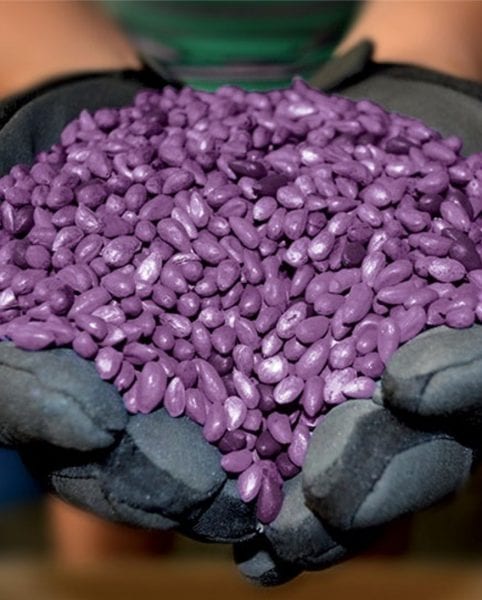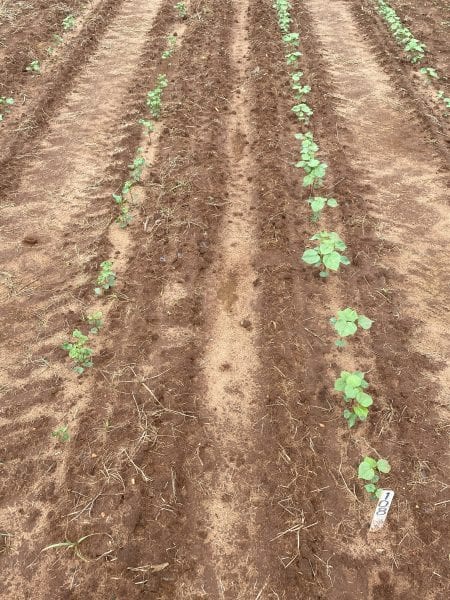Dr. Scott Graham, Auburn Crop Entomologist

Scott Graham, Auburn Row Crop Entomologist
As the 2021 cotton production season approaches, it is time to start preparing for thrips management.
Thrips are the dominate insect pest of seedling cotton in Alabama. Each year, thrips infest 100 percent of the acres planted statewide. Due to this, thrips must be managed with an at-plant insecticide. There are several options for at-plant management including insecticide seed treatments (ISTs), and in-furrow liquid or granular materials. Each approach has pros and cons; a specific strategy may make sense for one situation and not for another.
–
Insecticide Seed Treatments

Neonicotinoid insecticide seed treatments (IST) have begun to show reduced efficacy, but imidacloprid based products are still reccomended to reduce thrips pressure on cotton.
In recent years, the neonicotinoid insecticide seed treatments (IST) have begun to show reduced efficacy, particularly thiamethoxam. For this reason, we no longer recommend the use of thiamethoxam alone (Cruiser, Avicta) to manage thrips in cotton. If an IST is used, we recommend it be imidacloprid based. Examples of imidacloprid based ISTs include Gaucho and Aeris (imidacloprid + thiodicarb). Although not bullet proof in all cases, these products typically provide adequate protection from thrips under light to moderate pressure. Another option would be to treat seed with acephate (Orthene) or to supplement an imidacloprid IST with an additional treatment of acephate. The only problem with this approach is that once a bag of cotton seed is opened and over-treated, it cannot be returned if not planted in most cases.
–
In-Furrow Insecticides
Another option is to use in-furrow insecticides to supplement or replace ISTs. In-furrow liquid applications of imidacloprid generally provide very good control of thrips. Acephate may also be used and provides good control under the right conditions. Acephate should not be used in place of an IST as it does not provide long residual control and may be leached out of the rootzone prior to plant uptake under cool, wet conditions. Another option is AgLogic (aldicarb). This granular product provides excellent control of thrips and can also be used to manage nematodes as well.
–
Foliar Insecticides

In-furrow liquid applications of imidacloprid (right) generally provide very good control of thrips, as compared to the control (left).
Foliar insecticide applications should be made to supplement at-plant thrips management. Not be used as the “first line of defense.” Cotton is susceptible to thrips injury until around the fifth true leaf stage. Generally foliar applications are most effective when made at the 1 to 2 true leaf stage. The Thrips Infestation Predictor for Cotton can be used to show the relative risk of thrips injury for cotton planted at a given location and date. This model is used to help plan out fields or planting dates for cotton that will likely need a foliar application. Several options are available to use to supplement at-plant insecticides.
- Acephate (4-6 ounces per acre) is an effective and relatively inexpensive option, however it has the potential to flare secondary pests such as spider mites and is the least rainfast of the available recommended options.
- Bidrin (3.2 ounces per acre) is another option that is effective and less likely to flare spider mites and is more rainfast than acephate, however it is more likely to cause crop injury when tank-mixed with herbicides.
- Dimethoate (6.4 ounces per acre) is another cost effective and efficacious product with good rainfastness, however it is the most likely to cause crop injury when tank-mixed with herbicides.
- Intrepid Edge (3 ounces per acre) is another effective option. Intrepid Edge is less likely to flare secondary pests but may need the addition of a surfactant to help with efficacy.
- Pyrethroids are not effective and should not be used to manage thrips.
In order to get the 2021 cotton crop off to the best start possible, at-plant thrips management is a must. Supplemental foliar sprays may be necessary in certain situations, particularly with earlier planted cotton when nighttime temperatures are cool. More information about thrips can be found in Pests of Alabama Cotton: Thrips. For more information on thresholds and insecticide recommendations, visit the Alabama Cotton IPM Guide. Results from 2020 cotton insect research trials can be found in 2020 IPM Projects Advancing Alabama Cotton Production.
